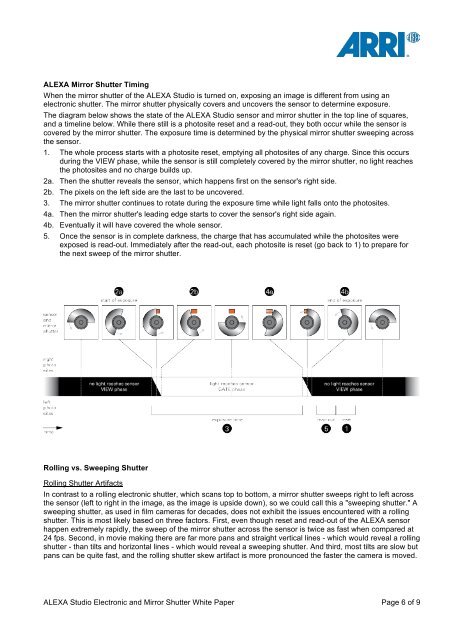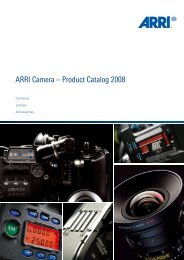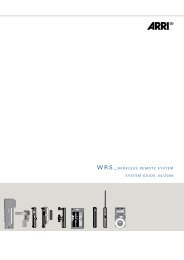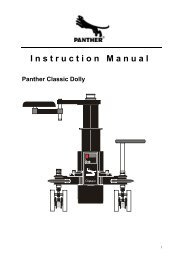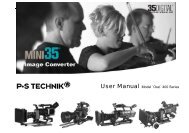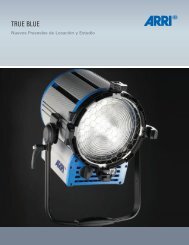ALEXA Studio Electronic and Mirror Shutter
ALEXA Studio Electronic and Mirror Shutter
ALEXA Studio Electronic and Mirror Shutter
Create successful ePaper yourself
Turn your PDF publications into a flip-book with our unique Google optimized e-Paper software.
<strong>ALEXA</strong> <strong>Mirror</strong> <strong>Shutter</strong> Timing<br />
When the mirror shutter of the <strong>ALEXA</strong> <strong>Studio</strong> is turned on, exposing an image is different from using an<br />
electronic shutter. The mirror shutter physically covers <strong>and</strong> uncovers the sensor to determine exposure.<br />
The diagram below shows the state of the <strong>ALEXA</strong> <strong>Studio</strong> sensor <strong>and</strong> mirror shutter in the top line of squares,<br />
<strong>and</strong> a timeline below. While there still is a photosite reset <strong>and</strong> a read-out, they both occur while the sensor is<br />
covered by the mirror shutter. The exposure time is determined by the physical mirror shutter sweeping across<br />
the sensor.<br />
1. The whole process starts with a photosite reset, emptying all photosites of any charge. Since this occurs<br />
during the VIEW phase, while the sensor is still completely covered by the mirror shutter, no light reaches<br />
the photosites <strong>and</strong> no charge builds up.<br />
2a. Then the shutter reveals the sensor, which happens first on the sensor's right side.<br />
2b. The pixels on the left side are the last to be uncovered.<br />
3. The mirror shutter continues to rotate during the exposure time while light falls onto the photosites.<br />
4a. Then the mirror shutter's leading edge starts to cover the sensor's right side again.<br />
4b. Eventually it will have covered the whole sensor.<br />
5. Once the sensor is in complete darkness, the charge that has accumulated while the photosites were<br />
exposed is read-out. Immediately after the read-out, each photosite is reset (go back to 1) to prepare for<br />
the next sweep of the mirror shutter.<br />
Rolling vs. Sweeping <strong>Shutter</strong><br />
Rolling <strong>Shutter</strong> Artifacts<br />
In contrast to a rolling electronic shutter, which scans top to bottom, a mirror shutter sweeps right to left across<br />
the sensor (left to right in the image, as the image is upside down), so we could call this a "sweeping shutter." A<br />
sweeping shutter, as used in film cameras for decades, does not exhibit the issues encountered with a rolling<br />
shutter. This is most likely based on three factors. First, even though reset <strong>and</strong> read-out of the <strong>ALEXA</strong> sensor<br />
happen extremely rapidly, the sweep of the mirror shutter across the sensor is twice as fast when compared at<br />
24 fps. Second, in movie making there are far more pans <strong>and</strong> straight vertical lines - which would reveal a rolling<br />
shutter - than tilts <strong>and</strong> horizontal lines - which would reveal a sweeping shutter. And third, most tilts are slow but<br />
pans can be quite fast, <strong>and</strong> the rolling shutter skew artifact is more pronounced the faster the camera is moved.<br />
<strong>ALEXA</strong> <strong>Studio</strong> <strong>Electronic</strong> <strong>and</strong> <strong>Mirror</strong> <strong>Shutter</strong> White Paper Page 6 of 9


